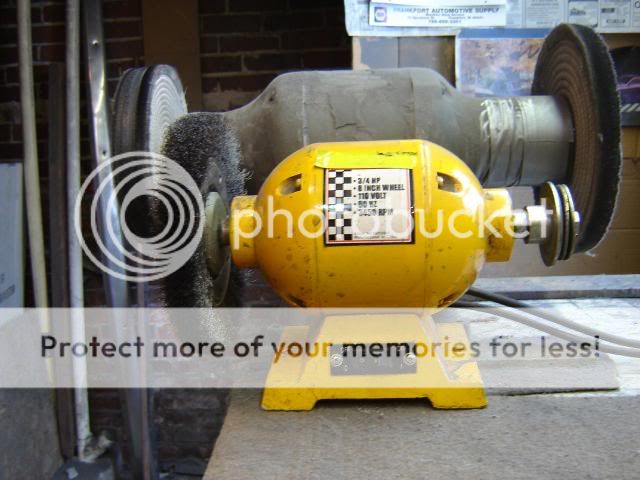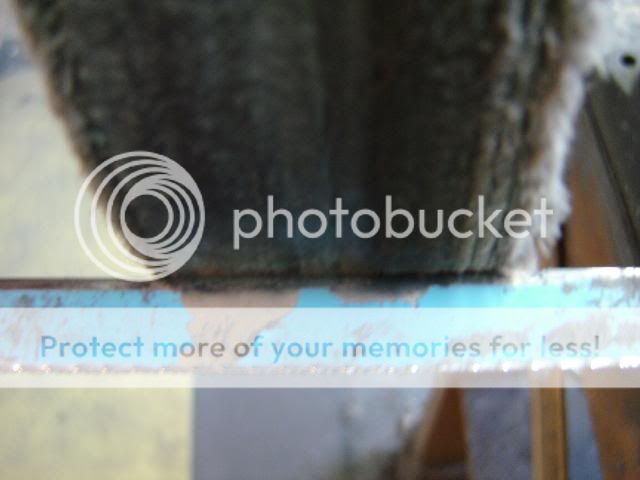|
Lark Parker
Cruiser Member
 
USA
235 Posts |
 Posted - 01/02/2008 : 1:13:29 PM Posted - 01/02/2008 : 1:13:29 PM



|
Each time I write one of these stainless items, I feel a little funny about just giving away "information" that I worked so hard to learn/invent. My wife says showing people how to do it is like explaining a magic trick. It takes all the mystery out of it and the fun is gone for the magician and the audience alike.
If you eventually end up as a stainless restorer for other Studebaker people -- be aware. There is one guy who walks by your swap service area and advises his newby Studebaker buddy, "All he does is just buff out old pieces." Ignore him. He's the same guy......nevermind....
If I wrote a book on stainless, this guy would stand there, block the other people's view, read my book, eat my free candy, not buy the book, and then....nevermind....
At the recent chapter Christmas dinner a Studebaker friend said: "Nobody could how learn to do it with what you are showing anyway." A slightly annoying statement when considering my effort to compose -- but it was a very true statement, nevertheless.
These postings are 90% intended to be things that you will NOT read on any other internet location and NOT an effort to teach the fundamentals of polishing and buffing. I taught myself and you will have to do the same as there is no "school". The effort here is to shorten the time to the results.
Occasionally some of that stuff will be repeated here, but those will usually be my version, changed from the usual. If you are interested in the subject, you should be searching out the fundamentals at other sites. I have a short list of those places and here's just one that has some good info (and some less than good info) :
www.caswellplating.com/buffs/buffman.htm
There is some advice on sizing buffing motors and wheels there.
Buffing motors can be made by adapting bench grinders provided they have sufficient horsepower AND clearance between the mounted wheel and the motor housing to accommodate the widest pieces that you intend to do. For (narrow) stainless pieces this is not important. I use a 3/4 hp Baldor bench grinder @ 3450 rpm and it has a shaft length is just enough to do a 15" wheelcover. The clearance distance from the wheel to the motor/base is the considered factor here.

DO NOT buy a cheap Chinese bench grinder for this purpose. Both of the motors in the picture are tagged 3/4 hp. The yellow one in the front appears larger than it really is because it is closer to the camera. The Chinese horses are evidently very tiny and a 3/4hp rated bench grinder doesn't have enough rotational torque to shine your shoes. Even looking at it intently as if you are thinking about using will slow it to a useless crawl. The one I have is relegated to using a fine wire brush wheel to clean paint and dirt from the back side of stainless. I can bog it down even doing that light work.
My big buffer is marked at 6.6 amps @ 110 volt, or 3.3 amps @ 220 volt. Similar amperage should put you in the ballpark in selecting a larger motor if you get very serious. If the amperage is not marked then you can assume that the Chinese horses are pulling it. I should think that a half horse motor with a smaller wheel would still get you some results but the ability to keep the speed up with a bigger motor is better if you can get one. My several big motors all came from auction sales for $65 or less. Be careful in buying a new long shafted buffing motor that you don't get one designed for woodworking at 1725 rpm. That speed would be OK for plastic lens polishing.
Size your buffing wheel(s) to the motor speed that you will be using by following the advice from the site in the second paragraph above. You can get motor shaft adapters at the supply sites. You might look under the equipment section of:
www.bright-works.com
You won't using more than one polishing grit (white) so ignore all the attempts to get you to buy wheels for each grit. Their advice is mostly directed towards people who are smoothing castings and polishing aluminum, not a Certified Highly Intensely Trained Professional Studebaker Stainless Restoration Master Craftsman such as yourself.
The buffing wheel that I use for stainless is 8" diameter and spiral sewn cotton. (The 1" x 10" wheel that is shown in the buffer picture has been an experiment for which I do not like the result.) The other type wheels (sisal, loose, etc) sold are for other purposes that do not interest you as a Certified Highly Intensely Trained Professional Studebaker Stainless Restoration Master Craftsman (CHITPSSRMC ).
The maximum thickness of the wheel is usually determined by the horsepower of the buffing motor and the thickness of the wallet. Wider wheels are easier to use. It is difficult to stroke a 1/2' wide piece of stainless on a 1/2" thick wheel without an occasional lapse of attention. This attention lapse can cause the the edge of the wheel to catch the edge of the stainless. The result will cause extra work with the straightening stage of the piece. If it is an irreplacable piece, you will be fortunate to get away with just some extra work.
Even with a reasonable wheel width, the best CHITPSSRMC can ocassionally slip off. You will get confidence and think you are getting good but you only need that to happen once to appreciate this tip: Wrap the shaft nut on the buffer with a thick layer of rubber tape and secure that with vinyl tape. Wrap it in the direction that the shaft's turning will tend to tighten the tape end rather than sling it loose. Also, cover the exposed inboard shaft with tape or a piece of hose.
The buffing wheels are commonly sold in 1/2" thickness and the desired working width can be achieved by stacking them. I use a three stack for most work and five stack for the broad 55 butterknife stainless pieces.
If you stack the wheels --- and before you mount them on the shaft, run your hand over the wheel edge in both directions. One direction will smooth down the nap and the other direction will fuzz the nap up. Orient all the stacked wheels in the same direction. You want all the wheels to be smoothed down by the stainless piece. This will speed up the amount of time before you will get quick results from new wheels. For what its worth(?) match up the wheels using spiral sewing pattern. ( I don't know how much that part helps but it costs you nothing and can't hurt.) If you are going to dismount the wheels and use them again some other time, ink marker them all with the direction of rotation.

I use the back of a hacksaw blade for cleaning/raking the buffing wheels. (Not a good picture but none of the four were and I'm too lazy to take more right now.) For my purposes I do not like to rake with anything that will leave grooves in the wheel. Clean the wheel whenever too much junk is being left behind on the stainless or whenever the wheel is seems to not be as effective. As a beginner you will probably clean more often than the work dictates. No harm, it just takes away some efficiency.
With reference to the Caswell site which showed the cutting stroke and the polishing/color stroke when using the wheel.
ALWAYS FINISH THE PIECE WITH AT LEAST TEN STROKES DOWNWARD -- NOT THE UPWARD CUTTING STROKE.
 Lark Parker Lark Parker
If at first you don't succeed -- you will get a lot of advice.
|
Edited by - Lark Parker on 01/02/2008 1:18:36 PM |
|


